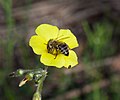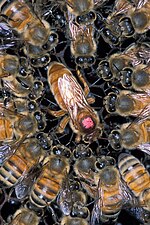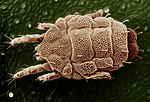Thelytoky (from the Greek θῆλυς thēlys "female" and τόκος tókos "birth") is a type of parthenogenesis and is the absence of mating and subsequent production...
16 KB (1,823 words) - 14:55, 14 August 2024
Hymenoptera (section Thelytoky)
fertilization. Thelytoky is a particular form of parthenogenesis in which female embryos are created (without fertilisation). The form of thelytoky in hymenopterans...
28 KB (2,804 words) - 23:35, 13 November 2024
haploid, male eggs. Not all workers are capable of thelytoky – only those expressing the thelytoky phenotype, which is controlled by a recessive allele...
14 KB (1,483 words) - 16:49, 20 October 2024
develop from the eggs of laying worker bees (with some exceptions, see thelytoky). A beehive cannot survive with only a laying worker bee. Even in a normal...
4 KB (580 words) - 09:10, 18 May 2024
which growth and development of embryos occur without fertilization. Thelytoky is a particular form of parthenogenesis in which the development of a...
19 KB (2,191 words) - 03:21, 12 August 2024
case of reproduction is thelytoky: the reproduction of female workers or queens by laying worker bees by parthenogenesis. Thelytoky occurs in the Cape bee...
20 KB (2,524 words) - 21:43, 24 September 2024
known to cause negative side effects such as cytoplasmic incompatibility, thelytoky, and feminization in the reproductive habits of these various insect species...
6 KB (749 words) - 01:52, 30 October 2024
"Fertile diploid males in the ant Cataglyphis cursor: a potential cost of thelytoky?". Behavioral Ecology and Sociobiology. 67 (12): 1983–1993. Bibcode:2013BEcoS...
25 KB (2,627 words) - 13:32, 19 November 2024
parthenogenesis in which females develop from unfertilized eggs is known as thelytoky; when both males and females develop from unfertilized eggs, the term...
5 KB (461 words) - 14:55, 14 August 2024
which growth and development of embryos occur without fertilisation. Thelytoky is a particular form of parthenogenesis in which the development of a...
29 KB (3,166 words) - 07:17, 12 October 2024
workers of the Cape honeybee, A. m. capensis. These lay diploid eggs ("thelytoky"), escaping normal worker policing, leading to the colony's destruction;...
119 KB (12,339 words) - 11:46, 11 November 2024
development of embryos occurs without fertilization by a male, a process called thelytoky. Lorryia formosa, originally found in Morocco, was first described by...
11 KB (1,119 words) - 20:30, 15 May 2024
diploid (and therefore female) fertile offspring in a process called thelytoky, in which the second set of chromosomes comes not from sperm, but from...
15 KB (2,091 words) - 00:46, 21 September 2024
no males have been observed. This form of parthenogenesis is known as thelytoky. Grubs grow up to 1 cm in length, have a slightly curved, legless body...
5 KB (483 words) - 06:01, 23 May 2024
parthenogenesis since it was discovered to have low levels of naturally occurring thelytoky. Drosophila mercatorum male Bisby F.A.; Roskov Y.R.; Orrell T.M.; Nicolson...
2 KB (156 words) - 00:05, 9 June 2022
mellifera subsp. capensis can reproduce asexually through a process called thelytoky. The freshwater crustacean Daphnia reproduces by parthenogenesis in the...
51 KB (5,390 words) - 03:43, 19 November 2024
unfertilized eggs, which are clones of their mother. All such young are females (thelytoky), so 100% of the population at these times can produce more offspring...
68 KB (6,825 words) - 15:21, 17 November 2024
which growth and development of embryos occur without fertilization. Thelytoky is a particular form of parthenogenesis in which the development of a...
3 KB (316 words) - 17:23, 20 April 2023
(reproducing without fertilisation), many species using arrhenotoky, a few using thelytoky. In Pezothrips kellyanus females hatch from larger eggs than males, possibly...
58 KB (6,179 words) - 07:21, 11 November 2024
and the offspring are clonal to their mother, so they are all female (thelytoky). The embryos develop within the mothers' ovarioles, which then give birth...
104 KB (11,371 words) - 14:25, 17 November 2024
yellow abdomen and opalescent wings. The species reproduces asexually via thelytoky induced by Wolbachia infection. Males are produced but are unable to inseminate...
4 KB (378 words) - 10:01, 18 November 2024
The production of female offspring by parthenogenesis is referred to as thelytoky (e.g., aphids) while the production of males by parthenogenesis is referred...
58 KB (6,326 words) - 01:45, 23 November 2024
which growth and development of embryos occur without fertilisation. Thelytoky is a particular form of parthenogenesis in which the development of a...
9 KB (981 words) - 03:51, 21 May 2024
which growth and development of embryos occur without fertilisation. Thelytoky is a particular form of parthenogenesis in which the development of a...
6 KB (517 words) - 19:58, 14 October 2023
population tolerance of environmental hazards. Parthenogenesis (also called thelytoky) is under the control of symbiotic bacteria of the genus Wolbachia, which...
67 KB (7,124 words) - 19:15, 11 October 2024
Brevipalpus species are made up mostly of female individuals that reproduce via thelytoky, producing offspring without fertilization. Male individuals occur but...
4 KB (444 words) - 13:01, 31 December 2023
including self-fertilization in plants and automictic parthenogenesis (thelytoky) in hymenoptera, tends to lead to the harmful expression of deleterious...
32 KB (3,765 words) - 04:12, 11 August 2024
a male. In some closely related species, the females instead undergo thelytoky, producing eggs without fertilization. Trichadenotecnum is well separated...
5 KB (501 words) - 02:19, 30 July 2021
eggs. On the San Jose scale however, though some females reproduce by thelytoky, other strains are arrhenotokous, with males being produced from unfertilised...
3 KB (388 words) - 17:31, 18 January 2024
Authorities suspect that in these populations, this species reproduces by thelytoky, that is, parthenogenisis in which unfertilized females produce female...
13 KB (1,290 words) - 02:16, 4 September 2024



























